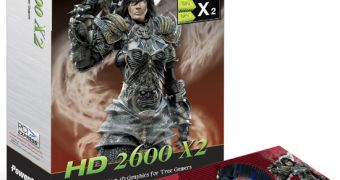Dual-GPU graphics cards are the new trend these days as they allow users to build pretty powerful gaming machines even on mainboards that are not equipped with multi card capabilities like SLI or CrossFire. While Nvidia-based multi graphics processing unit cards are not common it looks like AMD just discovered a whole new revenue avenue with its dual-GPU cards as more and more graphics cards manufacturing companies are beginning to design, produce and ship such cards.
Two important graphics card manufacturers, GeCube and Sapphire already launched their own implementations of the dual-GPU Radeon HD 2600 card and now it looks as if PowerColor does not want to stay too far behind as the company recently announced the soon to come HD 2600 X2 card which will be based on the same general architecture as the offerings from its competitors.
The PowerColor Radeon HD 2600 X2 integrates two Radeon 2600 graphics processing units from the R630 line and each of them comes with a 128 bits wide video memory interface, while running at a pretty high standard clock speed of 800MHz. According to the news site tcmagazine, the incoming PowerColor dual-GPU graphics card will feature an impressive 512MB of GDDR3 memory which will be shared equally between the two graphics processing units. The video memory will be clocked at a lower speed of 1400MHz than similar solutions from GeCube and Sapphire.
Apart from the indirect CrossFire capability that is derived from the presence of the two graphics processing units on the very same printed circuit board, the PowerColor Radeon HD 2600 X2 will also come with integrated support for CrossFire, so users really dreaming to build the ultimate gaming machine will be able to use up to four such graphics cards.
While the exact launch date is unknown and so is the price tag, the PowerColor offering is coming in a smaller form factor than similar product offerings from its main competitors, so users may find it easier to squeeze two of these cards in a normal, medium sized ATX computer case.

 14 DAY TRIAL //
14 DAY TRIAL //